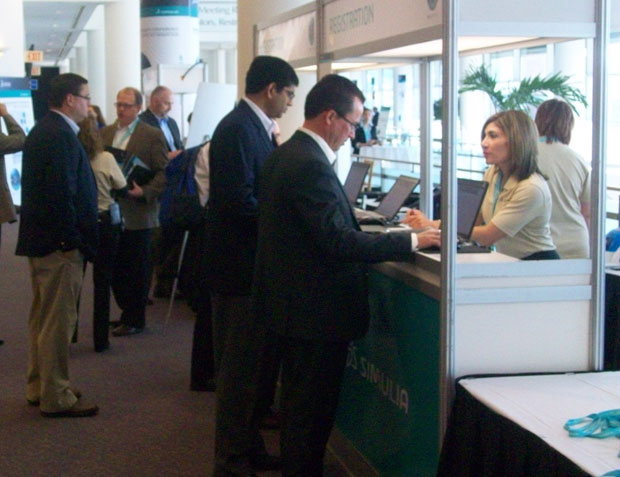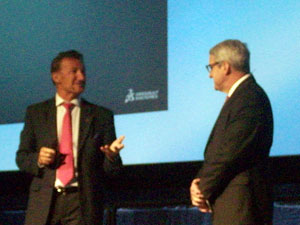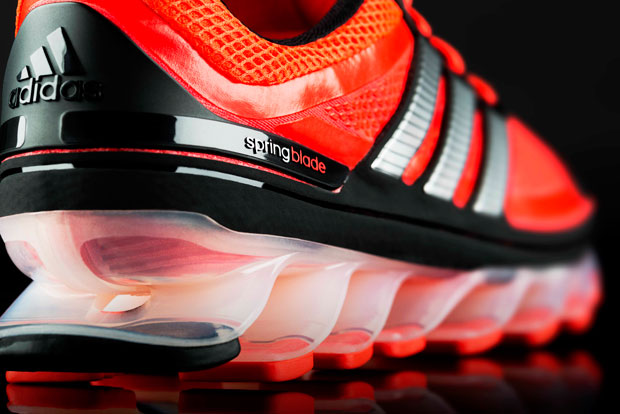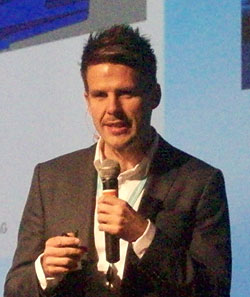
Collaboration and SIMULIA simulation software helped adidas develop the Springblade running shoe.
May 23, 2014
 SIMULIA said this year’s conference was the the best-attended SIMULIA Community Conference in its history.
SIMULIA said this year’s conference was the the best-attended SIMULIA Community Conference in its history.From May 19 to 22, over 400 Dassault Systemes SIMULIA users, company officials and engineers gathered at the Rhode Island Convention Center in Providence for three days of inspirational keynotes, technical breakout sessions, demonstrations, and networking on a variety of analysis and simulation topics. It was the best-attended SIMULIA Community Conference ever, with a full general session auditorium and overflowing breakout rooms.
 Bernard Charlès, president and CEO of Dassault Systèmes (left) and Scott Berkey, CEO, SIMULIA.
Bernard Charlès, president and CEO of Dassault Systèmes (left) and Scott Berkey, CEO, SIMULIA.Innovation was the key word behind the conference. Bernard Charles, CEO of Dassault Systemes, kicked off the event by declaring that we were in an economy where consumers expect their purchases to enhance their experience. This trend makes it critical to upgrade the technical experiences of the design engineer in order to meet the markets’ needs. Only by enabling better experiences for design engineers will they be able to deliver better experiences to their customers.
The opening keynote, by adidas design engineer Dan Price, focused on how different teams came together in the design of a revolutionary new running shoe, the adidas Springblade. Rather than traditional tread, the shoe incorporates spongy blades that bounce when in contact with the ground, giving runners a little extra spring to their step and helping to propel them forward.
Simulation let Adidas tune individual springs for different size Springblade shoes, Dan Price #SCC14— Desktop Engineering (@DEeditor) May 20, 2014
He focused on how the design of the Springblade was a collaborative effort across six different adidas departments. This included mechanical engineering, materials engineering, manufacturing and others in order to produce the best possible product. This enabled adidas to reduce time and cost, provide solutions at the product and component levels, provide confidence in decisions, facilitate collaboration, and helping to define the path of innovation.
 Collaboration and SIMULIA simulation software helped adidas develop the Springblade running shoe.
Collaboration and SIMULIA simulation software helped adidas develop the Springblade running shoe.Price noted that in the future, adidas and other design-focused companies would be attempting to move the simulation process further upstream in the design process. In the case of adidas, that means modeling materials at the molecular level to ensure that it is using the best possible materials to meet design goals.
 Dan Price, adidas design engineer, keynoted the 2014 SIMULIA Community Conference.
Dan Price, adidas design engineer, keynoted the 2014 SIMULIA Community Conference.Price plus several Dassault Systemes executives were decked out in the Springblade shoes on stage, illustrating their unique appearance and the design decisions that led to a radical change in how running shoes are conceived and manufactured.
The 3DEXPERIENCE Platform
On prominent display was the Dassault Systemes 3DEXPERIENCE platform, a framework that enables users to integrate multiple analysis and simulation activities into a single underlying experience, including data integration and visualization. Its goal is to tie together all of the disparate software products offered by Dassault Systemes, including those from SIMULIA, CATIA, SolidWorks and more.The Tuesday afternoon keynote illustrated a key facet of that innovation, in the form of collaboration by researchers at Harvard Medical School and MIT called “It’s Alive! Growing a Living Heart. O-matics or O-mics?” In this session, Dr. Kumarian Kolandaivelu explained how researchers were building detailed simulations of heart mechanics and blood flow in order to better understand heart defects and recommend better methods of treatment. This included collaborative elements where researchers were able to share their models with practitioners around the world at the click of a button in order to get opinions on treatment options. Read more on the Living Heart research here.
DS Simulia presents the Human Heart Project. “Time is ripe for simulation to change the study, development and practice of medicine.” #scc14— Desktop Engineering (@DEeditor) May 20, 2014
The end of day general session delivered a bit of fun into the proceedings, with young SIMULIA engineers explaining how they set out to solve the problem of getting emergency medical supplies to people around the world who didn’t have ready access to roads. The result was a “quad-copter,” a low-cost, remotely piloted four-rotor helicopter drone that could deliver medical payloads.
With videos, live descriptions, and on-stage components, SIMULIA engineers described how they took mission requirements and examined tradeoffs, created parts, constructed and tested prototypes and ultimately built a working quad-copter that also had very good manufacturability characteristics. The highlight of the presentation was a working quad-copter flying a payload across the stage and dropping it onto the floor.
Defining the Product Design Lifecycle
The Wednesday morning keynote focused on the design of Pratt and Whitney jet engines and how it took into account the surrounding airframe. Using an approach involving simulating the “system of systems,” speaker Brent Staubach described an approach where both the engine and airframe designed change in order to find the optimal combination.Confidence in low-fi models leads to simulating broader systems in higher fidelities, Brent Staubach, #SCC14— Desktop Engineering (@DEeditor) May 21, 2014
Expanding on the morning topic, the midday keynote focused on how organizations should look at product design as a process. While engineering organizations have their own individualized design processes, this approach looked at how to start with product requirements and build specifications through a process that went from high-level modeling to a detailed level of simulation. By enabling sensitivity analysis, engineers could easily look at tradeoffs across a range of different designs.
Later, in a roundtable with SIMULIA CEO Scott Berkey, he expounded on what the 3DEXPERIENCE platform means for users. He noted the applications embedded in the platform remained the same, and that even traditional engineering practices would see value from capabilities such as better and easier design visualization.
Berkey acknowledged that those organizations that had embraced enterprise-wide simulation practices were more likely to see the immediate value of the platform. “I can’t say that one industry or another is leading the charge,” he stated. “But those who understand that analysis, modeling, and simulation cut across departmental lines are more likely to take advantage of the features of the underlying platform.”
The 3DEXPERIENCE platform is sold as a stand-alone product. Beyond that, customers can buy industry-specific application packages with bundled pricing. “We worked hard to determine the best product configurations for different types of engineers, and believe that we are offering different industries the best possible packages for their unique needs.”
Dassault Systemes also used the conference to announce the rebranding of Accelrys, now BIOVIA. The purpose of BIOVIA is to provide industry and science the apps necessary to model the biosphere, and incorporates analysis as well as lifecycle and collaboration tools. According to Charles, “Accelrys’ (BIOVIA) strong suite of applications opens up a wide opportunity to support and develop systemic collaboration, project management, data and content reuse, traceability, and other processes, applications and integrations that are absolutely critical to scientific industries.”
Additionally, the conference was an opportunity to get user feedback on products. Attendees were invited into a demonstration room where they could use a variety of SIMULIA software products and discuss their own needs with engineers and fill out surveys. Having frank discussions with product engineers enabled users to have their voices heard as new features are designed, and older ones modified.
[gallery columns=“2” link=“file” ids=”/article/wp-content/uploads/2014/05/Simulia-Vendor-Tables-Expo.jpg|Exhibitors were on hand to discuss how their products work with SIMULIA.,/article/wp-content/uploads/2014/05/Simulia-Academic-Posters.jpg|Academics used posted to explain how using SIMULIA furthered their research. “]
Technology partners were well-represented at the SIMULIA Community Conference, with a number of solutions providers and resellers on hand to describe how SIMULIA products could provide a competitive advantage. In addition, there were several hardware partners, including AMD and NVIDIA, who discussed specific case studies of SIMULIA customers using their products and achieving high performance results.
The video below, produced by SIMULIA to promote the conference, provides some background on how this year’s conference differed from past events.
Subscribe to our FREE magazine, FREE email newsletters or both!
About the Author
Peter VarholContributing Editor Peter Varhol covers the HPC and IT beat for Digital Engineering. His expertise is software development, math systems, and systems management. You can reach him at [email protected].
Follow DE





